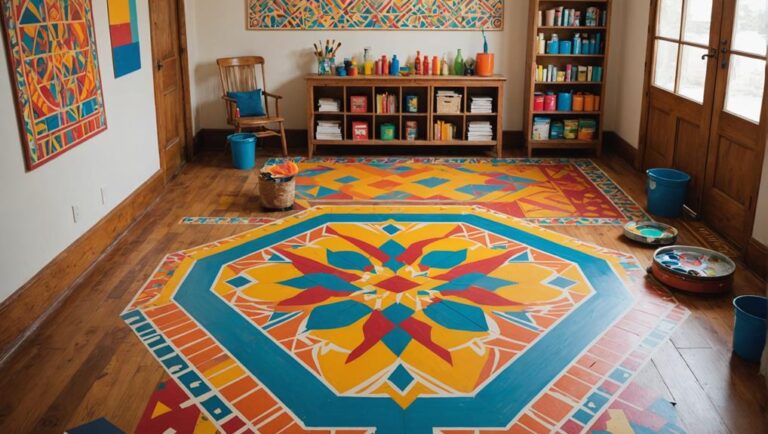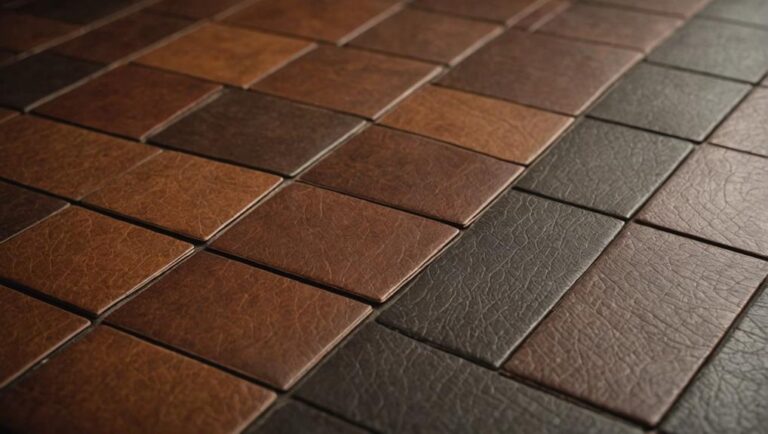To repair scratches and dents in your flooring, start with an essential repair kit that includes wood filler, sandpaper, and a putty knife. Scratch repair pens are great for blending colors on the surface, while heat tools like hairdryers can help reshape dents. Always clean the area before applying any filler or repair solution for best results. Sanding tools like orbital and belt sanders will smooth everything out, and finish with a protective sealant to preserve your work. This concise approach can make a significant difference in maintaining your floors, and there's plenty more to evaluate for ideal care.
Essential Repair Kits
When it comes to floor repair, having the right essential repair kits can make all the difference in achieving a seamless finish. Whether you're tackling scratches, dents, or other imperfections, knowing your repair kit essentials is key. Start with a good-quality wood filler or a vinyl repair compound, as these are vital for filling in gaps and smoothing out damaged areas.
You'll also want to include sandpaper in various grits; finer grits help achieve a smooth finish after filling. A putty knife or a similar tool is important for applying the filler evenly. If you're working with laminate or engineered wood, consider adding a color-matched repair marker or wax pencil to blend any repairs seamlessly into the existing floor.
For those who prefer DIY repair techniques, a small paintbrush can assist in applying stain or finish to your repaired area, ensuring it matches the rest of your flooring beautifully. Don't forget to keep a pair of safety gloves and a dust mask handy, as some materials can irritate your skin or lungs.
Heat Tools for Dent Removal
After addressing scratches and gaps with repair kits, you might encounter dents that require a different approach. Heat tools can be incredibly effective for dent removal, using heat application to soften the material, allowing the dent to pop back into place. When using heat tools, it's important to be cautious and follow safety guidelines to avoid damaging your flooring or causing injury.
Here are some key aspects to think about when using heat tools for dent removal:
- Select the Right Tool: Heat guns or hairdryers are commonly used. Make sure you can adjust the temperature for precise heat application.
- Distance Matters: Keep the tool at a safe distance from the surface to prevent scorching. About 6-12 inches is usually ideal.
- Monitor the Heat: Continuously move the heat source around the dent to evenly distribute heat. This helps avoid overheating any one spot.
- Use a Soft Cloth: After heating, place a soft cloth over the dent and apply gentle pressure to help it return to its original shape.
Scratch Repair Pens
The challenge of maintaining a flawless floor can be intimidating, especially when scratches mar its surface. Scratch repair pens offer a convenient and effective solution for minor surface blemishes, allowing you to restore your floor's appearance without the need for extensive repairs.
When selecting a scratch repair pen, make certain to choose one that's compatible with your flooring material—whether it's hardwood, laminate, or vinyl. This compatibility is vital for guaranteeing pen effectiveness, as using the wrong product can lead to further damage. Most pens come with a clear instruction guide, making the application process straightforward.
To use a scratch repair pen, start by cleaning the scratched area thoroughly. This step is essential for achieving the best results. Once the surface is clean and dry, gently shake the pen and apply it directly to the scratch. Be sure to fill in the scratch evenly, and don't worry if it looks a bit too dark at first; it will typically dry to match the surrounding area.
After allowing the pen to dry according to the manufacturer's instructions, inspect the repair. If necessary, you can apply a second coat for improved coverage. Always remember to test the pen on an inconspicuous area first to verify that it blends well with your floor.
Using scratch repair pens not only saves you time and money but also gives you the confidence to tackle minor flooring issues safely and effectively.
Fillers and Putty
For restoring deeper scratches, dents, or gaps in your flooring, fillers and putty can be your best allies. These products provide a seamless finish, making your floors look as good as new. When choosing the right filler, consider the various filler types available, including wood fillers, epoxy fillers, and vinyl patching compounds. Each type has its unique properties, so selecting one that matches your flooring material is essential for effective repair.
In terms of putty application, it's important to follow these steps for the best results:
- Clean the Area: Remove any debris or dust from the damaged spot to guarantee proper adhesion.
- Choose the Right Filler: Match the filler type to your flooring material for a more cohesive look.
- Apply Sparingly: Use a putty knife to apply the filler smoothly, only filling the damaged area without overfilling.
- Sand and Finish: Once the filler dries, sand it down to level it with the surrounding surface, then apply any necessary finish or sealant.
Always wear gloves and a mask during application to protect yourself from harmful dust particles and fumes. Following these guidelines will not only guarantee a safe working environment but also promise a successful repair. By effectively using fillers and putty, you'll restore the integrity and appearance of your flooring with confidence.
Microfiber Cloths and Applicators
Microfiber cloths and applicators are essential for cleaning and preparing your floors before any repair work. They effectively remove dust and debris, ensuring a smooth surface for applying fillers or finishes. To get the best results, use specific techniques for application, such as applying pressure evenly and using a circular motion for those tricky spots.
Cleaning and Preparation Techniques
When tackling floor repair, effective cleaning and preparation are fundamental, and using the right tools can make all the difference. Microfiber cloths and applicators are your best friends in this process, guaranteeing that your floors are clean and ready for any repair work. Here's how to get prepared:
- Establish a cleaning frequency: Regularly clean your floors to prevent dirt buildup that can interfere with repairs.
- Create a preparation checklist: Before starting, list all necessary steps to make sure you don't miss anything important.
- Use damp microfiber cloths: They're excellent for picking up dust and debris without leaving streaks, which is essential for a smooth repair surface.
- Choose appropriate applicators: Different applicators suit different types of repair products. Make sure you pick the right one for your specific needs.
Application Methods and Tips
Using the right application methods can greatly enhance the effectiveness of your floor repair efforts. When it comes to applying repair solutions, microfiber cloths and applicators are among the best tools you can use. These materials are designed to safely distribute products without scratching or damaging your floor's surface.
Start by choosing a high-quality microfiber cloth, as it effectively picks up dirt and debris, ensuring a clean repair area. For liquid repairs, consider using a microfiber applicator pad. This allows for even distribution of the repair solution, which is essential for achieving a seamless finish.
When applying your chosen repair technique, work in small sections. This helps you maintain control and prevents the product from drying too quickly. Remember to follow the manufacturer's instructions for any repair product you're using, as safety is paramount. Additionally, wear protective gloves to shield your hands from chemicals during the application process.
After you've completed the repairs, regularly check your floors for any signs of wear. Adopting these maintenance tips will keep your floors looking great and prolong the effectiveness of your repair work.
Sanding Tools
Sanding tools are essential for achieving a smooth and polished floor finish, transforming worn-out surfaces into beautiful, revitalized spaces. To get the best results, you'll need to familiarize yourself with various sanding techniques and the different sanding grits available. Each grit serves a specific purpose, from removing deep scratches to preparing the surface for finishing.
Here are some key sanding tools you should consider:
- Orbital Sanders: Ideal for lighter jobs, they're easy to handle and minimize swirl marks.
- Belt Sanders: Perfect for heavy-duty sanding, these tools can efficiently remove material quickly.
- Hand Sanders: Useful for touch-ups, they allow for better control in tight spaces.
- Sanding Blocks: These help in achieving a smooth finish and are great for detailed work.
When using sanding tools, always prioritize safety. Wear protective gear such as goggles and masks to guard against dust particles, and guarantee proper ventilation in your workspace. It's important to start with a coarser grit to tackle deeper imperfections, then gradually move to finer grits for a polished surface.
Keep in mind that each sanding technique requires a different approach. For example, when using a belt sander, maintain a steady motion to avoid gouges. By understanding the appropriate sanding grits and techniques, you'll not only enhance the appearance of your floors but also extend their lifespan, making your efforts worthwhile.
Floor Finish and Sealers
After achieving a smooth surface with your sanding tools, the next step is to apply the right floor finish and sealers to protect and enhance your floors. Choosing the appropriate finish is essential for effective floor maintenance, as it not only boosts the aesthetic appeal but also adds a layer of protective coatings that shield against scratches, stains, and moisture.
There are various types of finishes available, including polyurethane, varnish, and oil-based options. Polyurethane is a popular choice due to its durability and resistance to wear, making it ideal for high-traffic areas. If you're looking for a natural finish, consider oil-based products, which penetrate the wood and provide a warm glow while allowing for easy spot repairs.
Before you start applying the finish, make sure that the area is well-ventilated to avoid any harmful fumes. Wearing gloves and a mask can further enhance your safety during the application process. It's best to use a high-quality applicator, such as a foam brush or roller, to achieve an even coat. Generally, you'll want to apply at least two to three coats, allowing adequate drying time between each application.
Once your finish is applied and dried, remember that regular floor maintenance will help prolong the life of your finish. Sweep or vacuum regularly to remove dirt and debris, and consider adding area rugs in high-traffic spots for added protection. With the right finish and care, your floors will not only look great but will also withstand the test of time.
Cleaning Solutions
Cleaning your floors regularly is essential to maintaining their appearance and longevity. By using the right cleaning solutions, you can effectively remove dirt, grime, and spills without damaging your flooring. It's important to adopt safe cleaning techniques that protect both your floors and the environment. Eco-friendly solutions are a great way to achieve this, as they're less harmful to your health and the planet.
Here are some effective cleaning solutions you can use:
- Vinegar and Water: Mix equal parts of vinegar and water for a natural cleaner that cuts through grease and grime.
- Baking Soda Paste: Create a paste with baking soda and water to gently scrub away stains without scratching your floors.
- Castile Soap: This biodegradable soap is safe for all floor types and can be mixed with water for a gentle clean.
- Essential Oils: Adding a few drops of essential oils, like tea tree or lavender, not only helps with cleaning but also leaves a pleasant scent.
When using these eco-friendly solutions, remember to test a small, inconspicuous area first to verify compatibility with your flooring material. Always follow the manufacturer's recommendations for cleaning to avoid any potential damage. By employing these safe and effective cleaning techniques, you'll keep your floors looking their best while also prioritizing your health and the environment.
Protective Flooring Products
When repairing your floors, using protective flooring products is vital to guarantee long-lasting results. Essential repair kits provide you with everything you need for quick fixes, while surface protection solutions help safeguard your floors from future damage. By investing in these tools, you can maintain the integrity and appearance of your flooring over time.
Essential Repair Kits
To effectively tackle floor repairs, having the right essential repair kits at your disposal can make all the difference. These kits are designed to provide you with the necessary tools and supplies to handle various types of damage safely and efficiently. Understanding the different repair kit types available will help you choose the most suitable one for your needs.
Here are some essential tools you should look for in a repair kit:
- Wood Filler: Ideal for filling in gouges or scratches on hardwood floors.
- Vinyl Repair Compound: Perfect for mending cracks or tears in vinyl flooring.
- Color Matching Putty: Guarantees that your repairs blend seamlessly with the existing floor color.
- Sandpaper and Buffing Pads: Essential for smoothing out repaired areas and restoring a polished finish.
When selecting your repair kit, prioritize those that include high-quality materials and easy-to-follow instructions. Remember to always follow safety precautions, like wearing gloves and a mask, to protect yourself while handling these essential tools. With the right repair kit at hand, you can confidently restore your floors to their original beauty!
Surface Protection Solutions
After you've made the necessary repairs to your floors, protecting them from future damage becomes a priority. One effective way to achieve this is by applying surface sealants. These products create a protective barrier that helps resist scratches, stains, and moisture, guaranteeing your floors remain in pristine condition.
When choosing a surface sealant, consider the specific type of flooring you have, as different materials require different formulations. For instance, hardwood floors often benefit from oil-based sealants, while laminate and vinyl floors may need water-based options.
Another valuable option is protective coatings. These coatings not only enhance the appearance of your floors but also add an extra layer of durability. They can be particularly useful in high-traffic areas where wear and tear is more likely.
Before applying any sealant or coating, make sure the surface is clean and dry. Follow the manufacturer's instructions for best results, and always test a small area first to verify compatibility. By investing in these surface protection solutions, you'll extend the life of your floors and maintain a safe, attractive environment in your home.
Frequently Asked Questions
How Do I Choose the Right Repair Kit for My Flooring Type?
When choosing the right repair kit for your flooring type, consider the repair kit types available, like wax sticks for hardwood or epoxy for vinyl. It's essential to check for flooring compatibility; some kits work better with certain materials. Read the product labels carefully to guarantee safety and effectiveness. Don't forget to test any repair product in an inconspicuous area first, so you avoid damaging your flooring further. Your floors will thank you!
Can I Use Heat Tools on All Types of Flooring Materials?
You wouldn't use a torch on flimsy plastic, right? When considering heat tool effectiveness, it's essential to understand flooring material compatibility. While heat tools can be effective for some materials like hardwood or laminate, others—like vinyl or linoleum—might warp or melt. Always check the manufacturer's guidelines to guarantee safety. Testing a small, inconspicuous area first can help avoid costly damage, keeping your flooring looking pristine and intact.
Are Scratch Repair Pens Safe for Hardwood Floors?
Yes, scratch repair pens can be safe for hardwood floors if used correctly. When applying, make certain to follow pen application tips, like testing in an inconspicuous area first. Use light, even strokes to avoid over-saturation, which could damage the finish. Always choose a pen specifically designed for hardwood to guarantee compatibility with your floor's finish. Additionally, consider other scratch repair techniques if the damage is severe, ensuring your floor stays looking great.
How Long Does It Take for Fillers to Dry Completely?
When you're working with fillers, it's essential to know that filler drying times can vary based on the type you're using and the room's humidity. Generally, you can expect fillers to dry completely in 24 hours, but moisture can greatly impact this. In high humidity, drying may take longer, so it's best to check the manufacturer's instructions. Ensuring proper ventilation can help speed up the process while keeping your space safe.
What Is the Best Way to Maintain Repaired Areas After Finishing?
To maintain repaired areas effectively, you'll want to follow some key maintenance tips. First, avoid heavy foot traffic on the repaired spots for at least 48 hours. Regularly clean the area using a gentle cleaner to prevent dirt buildup. Consider applying a protective finish every few months to enhance repair longevity. Additionally, keep the humidity levels stable in your home, as fluctuations can affect the integrity of your repairs.




